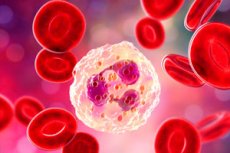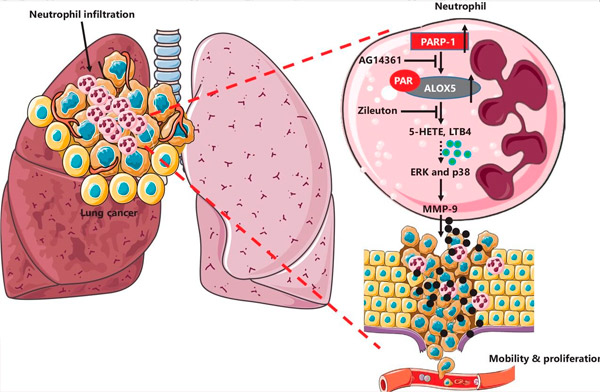Nye publikasjoner
Hvordan bidrar unormale nøytrofile celler til at lungekreft sprer seg?
Sist anmeldt: 02.07.2025

Alt iLive-innhold blir gjennomgått med medisin eller faktisk kontrollert for å sikre så mye faktuell nøyaktighet som mulig.
Vi har strenge retningslinjer for innkjøp og kun kobling til anerkjente medieområder, akademiske forskningsinstitusjoner og, når det er mulig, medisinsk peer-evaluerte studier. Merk at tallene i parenteser ([1], [2], etc.) er klikkbare koblinger til disse studiene.
Hvis du føler at noe av innholdet vårt er unøyaktig, utdatert eller ellers tvilsomt, velg det og trykk Ctrl + Enter.

Lungekreft er fortsatt et ledende globalt helseproblem og forårsaker det største antallet kreftrelaterte dødsfall på verdensbasis. Sentralt for utviklingen er svulstens mikromiljø, som inkluderer komplekse interaksjoner med immunceller som nøytrofiler. Nøytrofiler ble opprinnelig ansett som gunstige på grunn av deres antitumoraktivitet i tidlige stadier av kreft, men det er nå forstått at de spiller en dobbel rolle, og potensielt fremmer kreftmetastase under påvirkning av svulstmiljøet.
En banebrytende studie fra Xuzhou Medical University, beskrevet i tidsskriftet Cancer Biology & Medicine, avslører en ny mekanisme der nøytrofiler akselererer progresjon av lungekreft. Denne studien fremhever en nøkkelfunksjon til nøytrofiler – vanligvis de første som responderer på betennelse – ettersom de inntar pro-tumor-roller i kreftens mikromiljø, noe som påvirker dynamikken i kreftmetastase betydelig.
Studien undersøker rollene til PARP-1/Alox5/MMP9-aksen i reguleringen av nøytrofilaktivering assosiert med lungekreft og dermed fremme lungekreftprogresjon. Nøytrofiler aktiveres av lungekreftceller og samhandler med PARP-1, som deretter samarbeider med et annet protein, ALOX5. Denne interaksjonen er viktig fordi den forsterker produksjonen av MMP-9, et enzym som er viktig for å bryte ned vevsstrukturer og fremme kreftinvasjon og metastase.
Ved hjelp av teknikker som immunhistokjemi undersøker studien nøytrofilinfiltrasjon i lungekreftvev og bruker in vitro-analyser for å analysere effektene deres på lungekreftcelleatferd. Nedregulering av genuttrykk og farmakologisk hemming av PARP-1 belyser ytterligere dens rolle i denne prosessen.
Disse resultatene, som er bekreftet i musemodeller, viser at blokkering av PARP-1 kan redusere tumorvekst betydelig, noe som belyser det komplekse forholdet mellom immunsystemet og kreft, samtidig som det fremhever at synergistisk PARP-1-hemming kan være gunstig for behandling av lungekreft.

Skjematisk fremstilling av den nøytrofilmedierte PARP-1-ALOX5-mekanismen mediert av MMP-9 i lungekreft. Infiltrerte nøytrofiler er økt i kreftens lungevev og korrelerer negativt med pasientens prognose. Etter eksponering for nøytrofiler i lungekreftceller, interagerer PARP-1 med ALOX5 og forbedrer proteinstabilisering via ALOX5-PARillering. Økte ALOX5-metabolitter fremmer MMP-9-produksjon via aktivering av ERK- og p38 MAPK-veiene. Blokkering av PARP-1 med AG14361 eller ALOX5 med Zileuton reduserer MMP-9-produksjon og demper nøytrofilindusert lungekreftprogresjon. Kilde: Cancer Biology & Medicine (2024). DOI: 10.20892/j.issn.2095-3941.2023.0248
Dr. Junnian Zheng, hovedforfatter av studien, kommenterte: «Denne studien forbedrer ikke bare vår forståelse av de biologiske interaksjonene mellom lungekreftceller og nøytrofiler, men baner også vei for nye målrettede terapier som kan avbryte disse interaksjonene og potensielt forbedre resultatene for pasienter.»
Disse funnene har betydelige implikasjoner, og tyder på at det å målrette PARP-1-ALOX5-MMP-9-signalveien kan være en lovende tilnærming for å undertrykke nøytrofilprotumoraktivitet ved lungekreft. Denne strategien kan føre til innovative behandlinger som bremser lungekreftprogresjon og forbedrer effekten av nåværende behandlinger.
